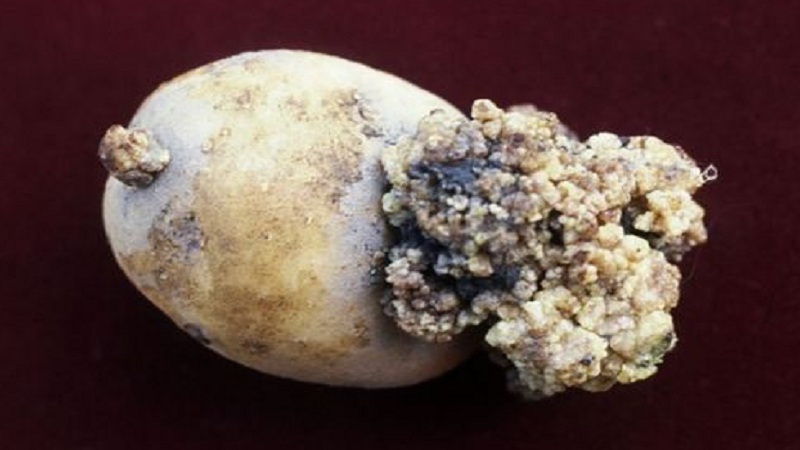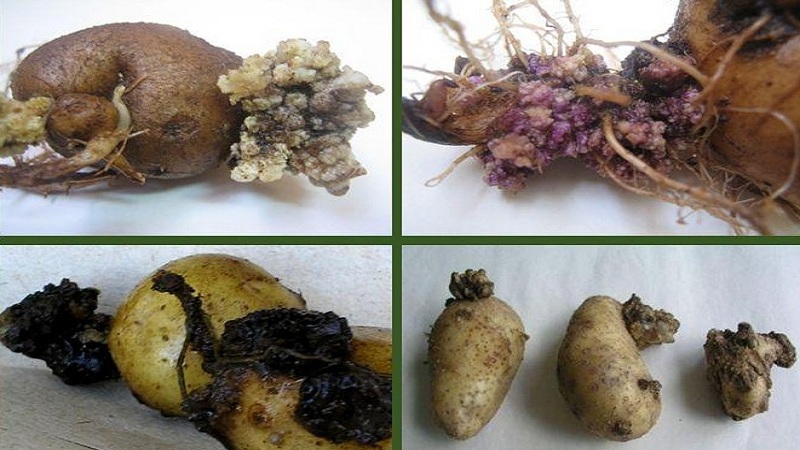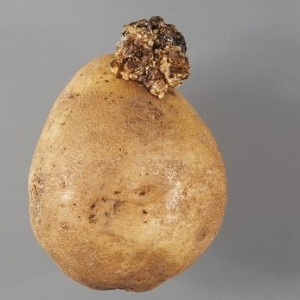How to deal with potato cancer and is it dangerous for humans
Potato cancer is a dangerous fungal disease. It was first discovered at the beginning of the twentieth century on the territory of Austria-Hungary, from where it spread throughout Europe.
Thanks to timely preventive measures and the development of varieties resistant to the pathogen, most farmers have never encountered this disease. But forewarned is forearmed.
From our article, you will learn how to respond promptly in case of infection and prevent the spread of fungal spores to neighboring areas.
The content of the article
What is potato cancer
Potato cancer is a quarantine disease that appeared at the beginning of the 20th century. In those areas where infected tubers were found, strict quarantine is introduced in order to prevent the spread of the pathogen.
The photo shows a potato infected with cancer.

Features of the pathogen
The causative agent of cancer is the pathogenic intracellular obligate fungus Synchytrium endobioticum (Schilb.) Perc, parasitizing on potatoes, physalis, tomatoes, affecting the rhizome.
For reference. The parasite is susceptible to low and high air temperatures. The fungus is most common in temperate countries. In the north, where the ground freezes to -11 ° C, and in the south, where the soil warms up to + 30 ° C, there is no potato crayfish.
The pathogen overwinters in the form of zoosporangia. These are microscopic cysts with a dense membrane. In spring, 200-300 zoospores appear. In the soil, zoosporangia persist for up to 30 years.
The parasite actively develops at a soil temperature of + 15 ... + 18 ° C and a humidity of 80%. This environment is also ideal for potato development. More than 50% of zoosporangia are formed in June-July, during the period of active tuberization.
Zoospores move along the capillaries of the soil. If within 12 hours they do not have time to penetrate the cell system of the potato, they die. In a favorable environment, the parasite develops due to the toxins secreted by it. Adjacent cells enter the phase of intensive division, forming growths. Further, new zoosporangia appear in the center of the growth.
For reference. The life cycle of a pathogen is 12-14 days. Over the entire growing season of potatoes, 15-17 generations appear on the site.
Scientists have proved that, provided that 1 g of soil contains one cyst, the yield loss will be at least 10%. If there are 25 sporangia per gram of soil, about 60% of the potatoes will die.
Varieties of potato cancer

In hot summer conditions, the pathogen takes other forms:
- Leafy. The growths on the tubers resemble oyster mushrooms or fleshy foliage.
- Corrugated. Uneven, bumpy growths appear on potatoes, the skin becomes wrinkled.
- Scabby. A large number of small areas of scab are formed on the surface of the tubers.
- Crater-shaped. Convex, rounded neoplasms with uneven edges, resembling craters, form on potatoes. The diameter of the recesses is 1-1.5 cm.
Sources of infection
Scientists identify several of the most likely sources of infection:
- farmer's clothing and footwear;
- contaminated work tool;
- excrement from farm animals fed with infected tubers;
- melt water;
- earthworms;
- insects;
- planting infected seed.
Propagation paths
Potato cancer spreads through infected tubers or potatoes of disease-resistant varieties contaminated with particles of infected soil. Contaminated tools, shoes, animal hooves, any containers for storing potatoes create a focus of the disease.
Zoosporangia are carried by streams of melt water and rain from elevated areas.
Having passed through the digestive tract of animals, the spores do not die, and together with the feces they again fall into the ground.
There are known cases of importation of infected seed material from contaminated areas. A negligent attitude towards quarantine rules leads to an increase in the area of infection and the loss of a large amount of crops.
Signs of damage to potatoes

It is impossible to recognize the disease during the growing season, since fungal spores do not infect the ground part of the plant.
In autumn, after digging, whitish tubercles, dark growths resembling warts, are found on the tubers. Their size sometimes exceeds the size of a potato.
The shape of the neoplasms is similar to cauliflower inflorescences. Smaller bumps are formed on stolons.
By the time of harvest, most of the infected tubers completely rot in the soil, the rest - in the first month of storage, while infecting healthy potatoes.
Control methods
If infected tubers are found on the plot, the farmer must notify the plant protection inspectorate.
Important! Diseased potatoes should not be eaten or used as animal feed.
Winter zoosporangium has a strong shell and dies only at a boiling temperature of + 100 ° C. Infected tubers are best destroyed. Scientists have not yet come to a consensus regarding their harmlessness to humans and animals.
A patient with cancer, potatoes are burned along with tops or thrown into a meter-long pit and sprinkled with bleach, poured with formalin, kerosene.
In the fight against potato cancer, an important role is played by proper agricultural technology, the choice of varieties with immunity to the pathogen and treatment with fungicides. Folk remedies based on herbs and improvised remedies are powerless against this disease.
Agrotechnics
In spring, only 30% of winter zoosporangia are activated. Agrotechnical techniques are used to enable cysts to open, and zoospores died without a host plant.
Agricultural techniques:
- Crop rotation. After potatoes, corn, rye, peas, lupines, beans are planted. The roots of these plants secrete a special substance that promotes the release of zoospores.
- Application of manure to the soil - 300 kg / 100 m². For soil disinfection in the greenhouse, granular urea is used - 1.5 kg / 1 m².
- Treatment of seed material before planting.
- Timely harvesting of weeds and nightshade tops.
- Moderate watering. In waterlogged soil, spores spread faster.
- A ban on the cultivation of perennial grasses in contaminated areas.
- Selection of potato varieties with cancer resistance. Such crops are sensitive to the influence of zoospores. The affected cell immediately dies, and the cells around it become dense, forming pustules, in which the dead parasite is imprisoned. Healthy plant tissues push out the pustule and the wound heals. Agronomists advise planting only such varieties for 5-6 years to completely cleanse the soil from the pathogen. It is advisable to change varieties with immunity to cancer every four years to prevent pathogen resistance.
Chemicals
Fungicides are used to disinfect the planting material. The tubers are soaked in a 1% solution of "Fundazol" or a 0.5% solution of "Benleita" for 30 minutes. Such treatment improves seed germination, increases crop productivity, and strengthens the immune system.
To eliminate the focus of infection, the soil is treated with pesticides. Take 20 liters of 2% solution of "Nitrofen" for 1 m². The procedure is only trusted by specialists. Agricultural plants cannot be cultivated on the site for 2-3 years.
Quarantine
List of quarantine measures:
- systematic inspection of potato plantings;
- a ban on the transport of potatoes from contaminated areas;
- elimination of foci of infection;
- disinfection of foci in areas with fruit and berry crops.
Danger to humans
Infected tubers do not pose a danger to human health, but eating disfigured potatoes is not recommended... The worst thing that can happen when eating sick tubers is diarrhea.
In any case, this does not make sense, since the product completely loses its taste and becomes tasteless.
Cancer-resistant potatoes
Early maturing potato varieties with cancer immunity are presented in the table.
| Name | Originator | Coloration | Mass of tubers | Yield |
| Pushkinets | FGOU VPO "Tver State Agricultural Academy" | Skin - creamy, pulp - white | 100-130 g | 290-320 c / ha |
| Zhukovsky early | FSBSI "All-Russian Research Institute of Potato Farming" A. G. Lorkha " | The skin is pink, the pulp is white | 100-120 g | 400-450 c / ha |
| Madeleine | Agrico U.A. | Skin and pulp - yellow | 84-118 g | 164-327 c / ha |
| Molly | Norika Nordring-Kartoffelzucht-Und Vermehrungs-GmbH | Peel and flesh - yellow | 98-142 g | 171-308 c / ha |
| Spring white | FSBSI "Institute of General Genetics named after N. I. Vavilova | Skin - yellow, flesh - white | 100-180 g | 270-380 c / ha |
| Rosalind | EUROPLANT Pflanzenzucht GmbH | The peel is red, the flesh is yellow | 60-115 g | 203-259 c / ha |
| Juvel | Bavaria-Saat Vertriebs GmbH | Yellow rind and flesh
|
80-150 g | 450-750 c / ha |
| Impala | Agrico U.A. | Skin - yellow, flesh - light yellow | 88-150 g | 180-360 c / ha |
| Elmundo | STET HOLLAND B.V. | Yellow skin and flesh | 106-135 g | 248-345 c / ha |
| Tiras | Polesskaya Experimental Station named after Zasukhina "Institute of Potato Growing NAAS" | Peel - pink, flesh - white | 115-140 g | 210-460 c / ha |
| Romano | Agrico U.A. | Skin - pink, flesh - light cream | 70-80 g | 110–347 c / ha
|
| Colomba | HZPC HOLLAND B.V. | Yellow pulp and skin | 82-126 g | 224-422 c / ha |
| Labella | DEN HARTIGH B.V. | The skin is red, the pulp is yellow | 78-102 g | 176-342 c / ha |
Medium early potato varieties resistant to cancer
| Name | Originator | Coloration | Weight | Yield |
| Arizona | Agrico U.A. | Skin - yellow, flesh - light yellow | 112-150 g | 225-577 c / ha |
| Svitanok Kiev | Institute of Potato Growing of the Ukrainian Academy of Agrarian Sciences | Skin - light pink, flesh - yellow | 90-120 g | 250-460 c / ha |
| Nevsky | FSBSI "Leningrad Scientific Research Institute of Agriculture" Belogorka " | Skin - beige, pulp - white | 90-130 g | 380-500 c / ha |
| Condor | Agrico U.A. | Skin - red, flesh - light yellow | 88-176 g | 184–357 c / ha |
| Red fantasy | Europlant pflanzenzucht GMBH | The peel is red, the flesh is rich yellow | 92-140 g | 256–393 c / ha |
| Sante | Agrico U.A. | Skin - yellow, flesh - light yellow | 100-120 g | 250-340 c / ha |
| Adretta | Norika Nordring-Kartoffelzucht und Vermehrungs GmbH | The peel is yellow, rough, the pulp is light yellow. | 100-150 g | 400-460 c / ha |
| Tuscany | Solana | Peel and flesh - yellow | 90-125 g | 210-460 c / ha |
Mid-late potato varieties
| Name | Originator | Coloration | Weight | Yield |
| Grandee | "All-Union Research Institute of Potato Economy named after A. G. Lorkha " | The peel is red, the flesh is yellow | 92-104 g | 114-506 c / ha |
| Victoria | HZPC HOLLAND B.V. | Skin and pulp - yellow | 92-213 g | 302-430 c / ha |
| Blue | "All-Russian Research Institute of Potato Economy named after A. G. Lorkha " | The peel is beige with shallow blue eyes, the flesh is creamy | 90-110 g | 400-500 c / ha |
| Lugovskoy | "Institute of Potato Growing of the Ukrainian Academy of Agrarian Sciences" | Skin - light pink, flesh - white | 85-125 g | 340-515 c / ha |
| Lasunak | "Scientific and Practical Center of the National Academy of Sciences of Belarus for Potato and Horticulture" | Skin - light yellow, flesh - cream | 150-200 g | 400-620 c / ha |
| Picasso | Agrico U.A. | The skin is yellow, with pink blotches and small eyes, the flesh is creamy | 75-126 g | 190-315 c / ha |
| Merlot | Norika Nordring – kartoffelzucht – und vermehrungs – GMBH | The peel is red, the pulp is rich yellow | 90-140 g | 190-504 c / ha |
Prevention of the disease
To prevent contamination of potato plantings:
- observe the principle of crop rotation and plant potatoes in the same place no more than once every four years;
- other nightshade crops are not planted next to the potato beds;
- weeding of weeds;
- carefully select seed material;
- varieties with immunity to potato cancer are planted near the quarantine zone.
Conclusion
Cancer of potatoes is often found in areas whose owners do not follow the basic rules of weed harvesting and crop rotation. The causative agent of the disease is distinguished by its vitality and remains in the ground for about 30 years.One of the most effective ways to combat the disease is considered to be the cultivation of varieties of potatoes that are immune to cancer.
In order to completely cleanse the soil from zoospores, it is recommended to plant resistant varieties for 5-6 years, observe crop rotation, disinfect tubers before planting, and carefully choose seed material.